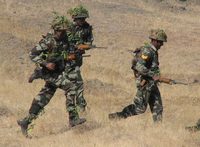Editor’s note: This is the first in a two-part series on India’s strategic engagement in Central Asia. Part one examines ties with Tajikistan and Kyrgyzstan. Part two will examine ties with Uzbekistan and Kazakhstan.
India’s engagement with Central Asia on strategic military concerns is gathering pace, with visits by high-ranking Indian defense officials and security cooperation deals underscoring the immense value New Delhi attaches to its growing military relationship with the region. The strengthened Indian presence in the area is driven by New Delhi’s desire not only to protect its emerging investments in Central Asia, but also its interests in Afghanistan after NATO withdraws in 2014.
In both Tajikistan and Kyrgyzstan, India is stepping in to resurrect former Soviet sectors -- military as well as civilian -- in addition to providing much-needed training to organically grow a military presence beyond its borders just north of Kashmir. The centerpiece of India’s power-projection activities in Central Asia is the Ayni airbase, just south of the Tajik capital, Dushanbe. India began to modernize the base beginning in 2002, but its status since the renovations were completed in 2010 has remained the subject of confusion. Russia reportedly objected to India’s use of the former Soviet base and had entered into negotiations with Tajikistan to use the base itself. Official statements out of Dushanbe seemed to rule out use of the base by India. However, an Indian official directly involved in renovating the airfield told World Politics Review that an Indian air force contingent, including Indian Mi-17 helicopters and leased Russian fighter jets, is currently deployed to the base under joint Indo-Tajik control. The Russian equipment will be maintained by Russian contractors, creating “a sort of joint control over these assets.” His comments echo recent reports of negotiations between the three parties for joint use of the base.
India has spent almost $70 million, including equipment costs, to completely repave and extend the runway at Ayni, set up air traffic control and perimeter fencing and build three hardened shelters -- all, the Indian official confirmed, with an eye to supporting fighter-jet operations. That might be the real reason behind Tajikistan’s reticence to officially clarify the status of the base. While Ayni will allow India to watch over northern Afghanistan in the aftermath of a NATO withdrawal, it can also provide coverage for Indian fighter aircraft over northern Pakistan and western China, areas that lack robust air defense networks. Tajik officials might be downplaying their involvement in the base out of deference to Beijing and Islamabad’s sensitivities.

